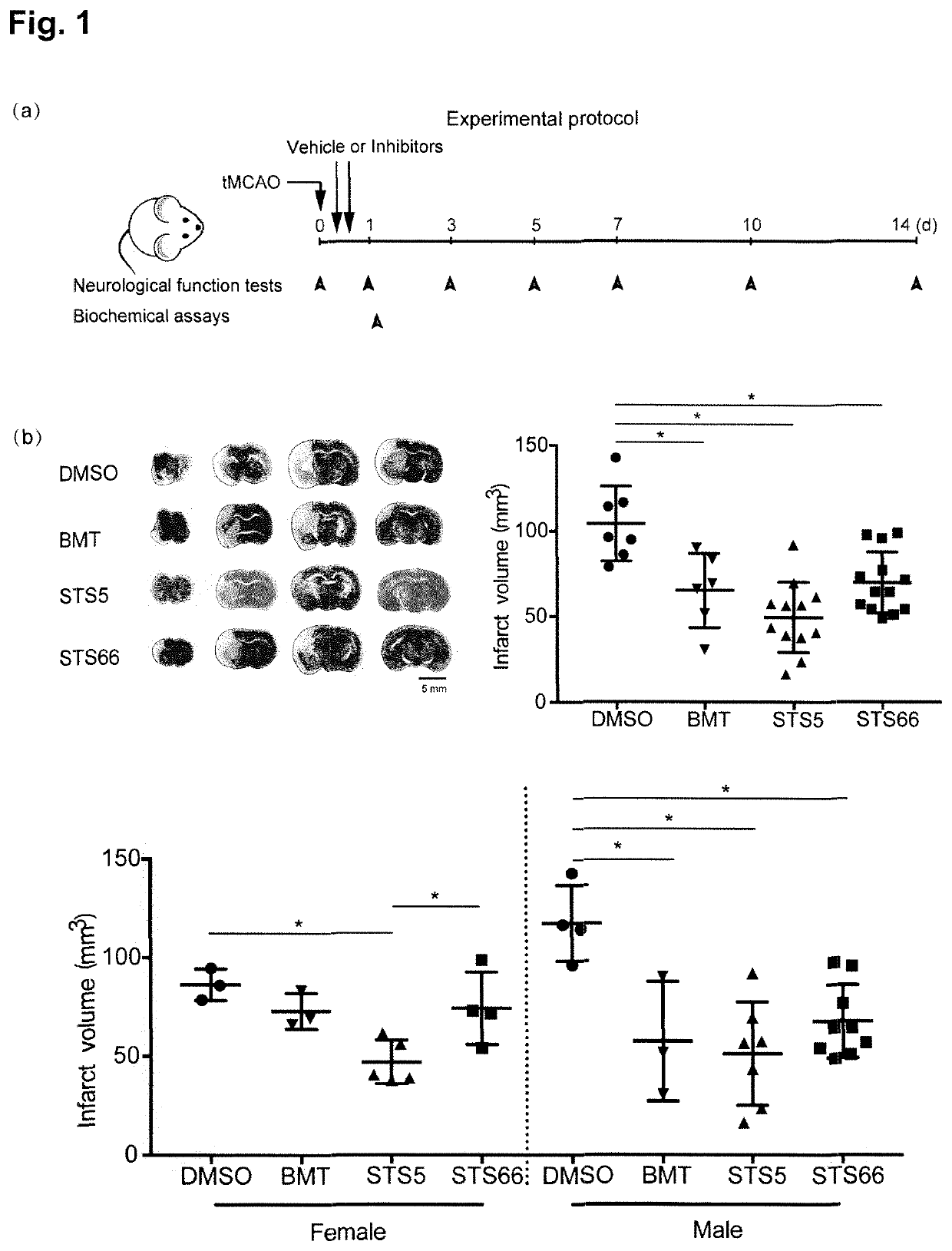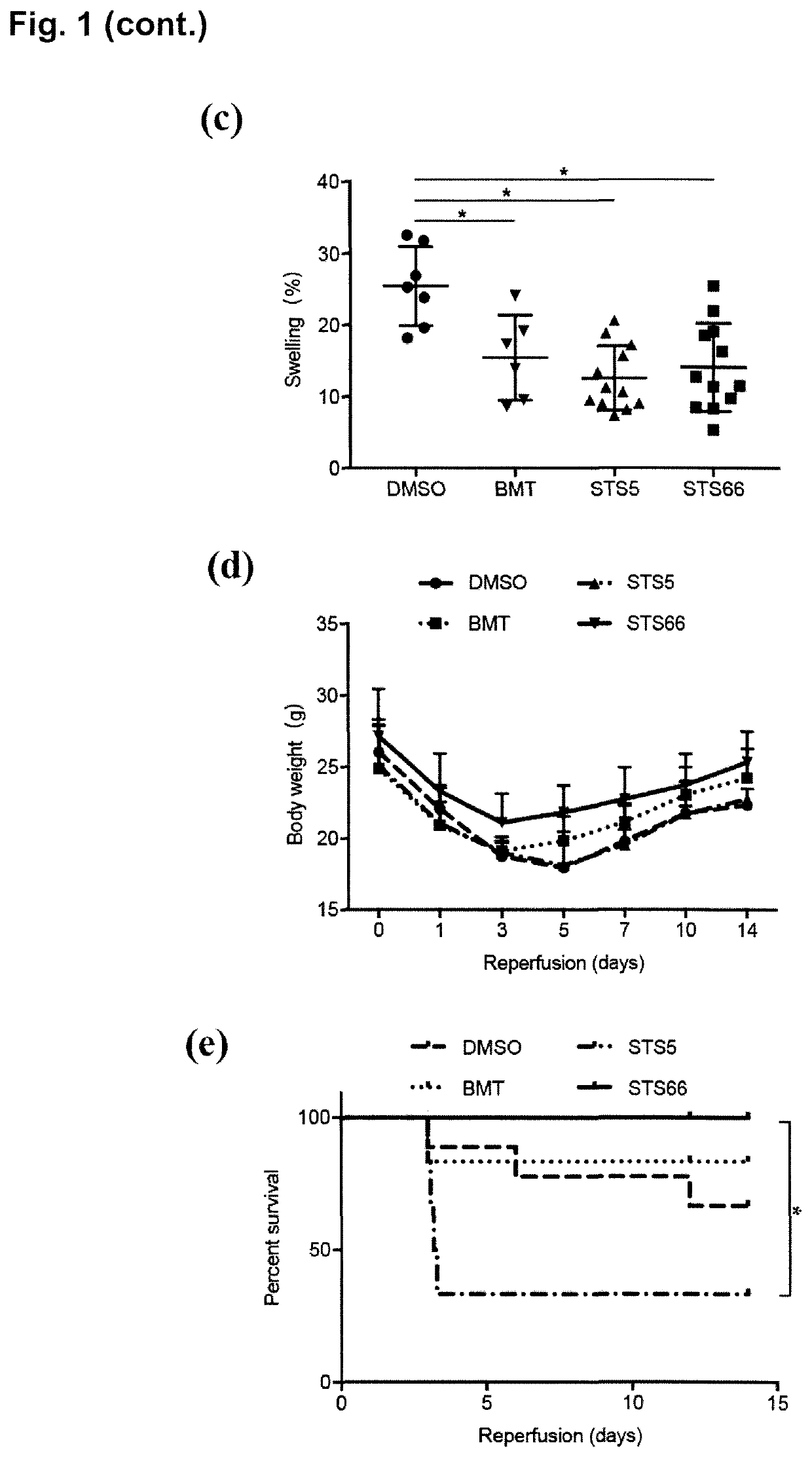Bumetanide Derivatives for the Therapy of Stroke and Other Neurological Diseases/Disorders Involving NKCCs
a technology of nkccs and derivatives, applied in the field of nkccs stroke and other neurological diseases/disorders involving nkccs, can solve the problems of ineffectiveness, failure of neuronal growth and synaptic maturation, excitotoxic death, etc., and achieves improved skin penetration, improved lipophilicity, and improved properties.
- Summary
- Abstract
- Description
- Claims
- Application Information
AI Technical Summary
Benefits of technology
Problems solved by technology
Method used
Image
Examples
example 1
of Various Compounds According to the Invention
[0126]General Methods
[0127]All chemicals and solvents were purchased from commercial suppliers (Sigma Aldrich, Merck, Apollo Scientific and TCI Europe) at analytical grade. Bumetanide was obtained from OChem Inc., Des Plaines, Ill., US.
[0128]To monitor reactions via thin layer chromatography, silica gel F254 coated aluminum sheets from Merck were used.
[0129]As a stationary phase for column chromatography silica gel 60 70-230 mesh ASTM from Merck was used.
[0130]Melting points were measured on a ThermoGalen Kofler hot stage microscope.
[0131]1H- and 13C-NMR spectra were recorded on a Bruker Advance (200 and 50 MHz respectively) and chemical shifts are reported in ppm relatively to the solvent residual line or tetramethylsilane as internal standard.
[0132]Mass spectra were recorded on a Shimadzu (GC-17A; MS-QP5050A) spectrometer. The peak intensity is specified in per cent relative to the biggest signal in the spectrum.
[0133]Elemental analys...
example 2
ibitory Activity of the Compounds According to the Invention
[0156]The compounds of formula (I) according to the present invention are inhibitors of Na+—K+-2Cl−-cotransporters (NKCCs), particularly of NKCC1. The NKCC1 inhibitory activity of the compounds of the invention can be determined, for example, using the following NKCC1A activity assay.
[0157]To activate NKCC1A prior to the uptake experiment, hNKCC1A-expressing oocytes (Lykke, K., et al. 2016) or uninjected control oocytes are pre-incubated for 30 min at room temperature in a K+-free solution. To measure K+ influx, oocytes are exposed to an isosmotic test solution in which KCl is substituted for choline chloride and 86Rb+ is added as a tracer for K. Bumetanide (positive control), a compound of formula (I) according to the invention (“drug”), or control vehicle (negative control) are added to the test solution. The uptake assay is then performed at room temperature with mild agitation for 5 min. The influx experiments are termi...
example 3
f the Compounds According to the Invention on Reducing Brain Damage and Neurological Deficits After Ischemic Stroke in Mice
[0158]Introduction
[0159]Stimulation of the WNK-SPAK / OSR1 kinases and their substrate Na+—K+2Cl− cotransporter 1 (NKCC1) play critical roles in cerebral edema and neurological functional deficits after ischemic stroke. Either NKCC1 inhibitor bumetanide (BMT) or knockout of WNK3 or SPAK shows profound protective effects in a mouse model of ischemic stroke. In this study, the efficacy of two pharmacological inhibitors of NKCC1, i.e. the novel NKCC1 inhibitor STS66 which is an exemplary compound of formula (I) according to the present invention, as well as the lipophilic BMT prodrug STS5 (reference compound), on reducing ischemic stroke-induced brain damage in mouse were investigated.
[0160]Material and Methods
[0161]Materials
[0162]Bumetanide (BMT) and AngII were from Sigma (Sigma-Aldrich, St Louis, Mo., USA). STS5 is described in Erker et al., 2016 (where it is refer...
PUM
| Property | Measurement | Unit |
|---|---|---|
| molecular weight | aaaaa | aaaaa |
| body weight | aaaaa | aaaaa |
| body weight | aaaaa | aaaaa |
Abstract
Description
Claims
Application Information
 Login to View More
Login to View More - R&D
- Intellectual Property
- Life Sciences
- Materials
- Tech Scout
- Unparalleled Data Quality
- Higher Quality Content
- 60% Fewer Hallucinations
Browse by: Latest US Patents, China's latest patents, Technical Efficacy Thesaurus, Application Domain, Technology Topic, Popular Technical Reports.
© 2025 PatSnap. All rights reserved.Legal|Privacy policy|Modern Slavery Act Transparency Statement|Sitemap|About US| Contact US: help@patsnap.com



